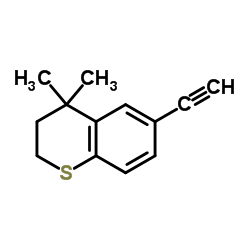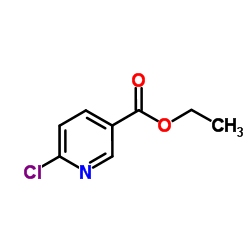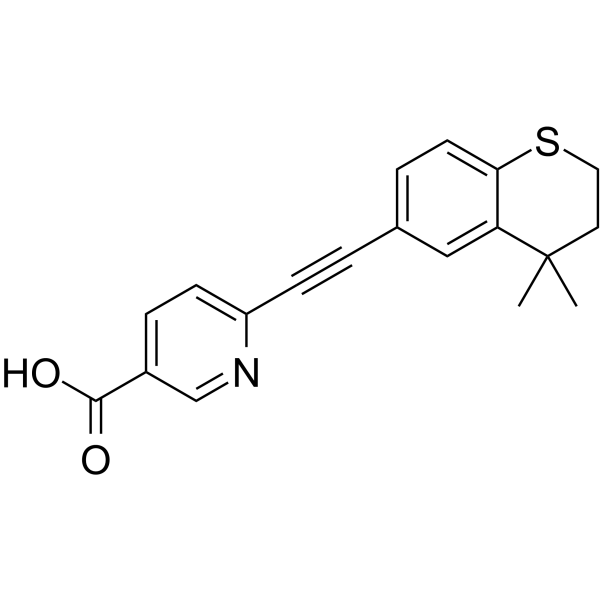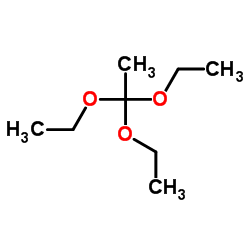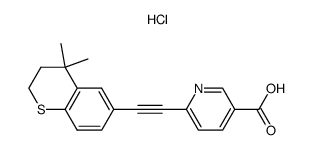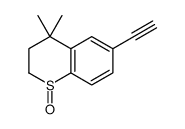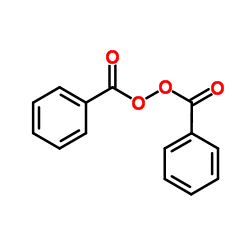118292-40-3
| Name | tazarotene |
|---|---|
| Synonyms |
3-pyridinecarboxylic acid, 6-[(3,4-dihydro-4,4-dimethyl-2H-1-benzothiopyran-6-yl)ethynyl]-, ethyl ester
Avage Ethyl 6-[(4,4-dimethyl-3,4-dihydro-2H-thiochromen-6-yl)ethynyl]nicotinate ethyl 6-[2-(4,4-dimethyl-2,3-dihydrothiochromen-6-yl)ethynyl]pyridine-3-carboxylate 6-[(4,4-diméthyl-3,4-dihydro-2H-thiochromén-6-yl)éthynyl]pyridine-3-carboxylate d'éthyle 6-[(3,4-Dihydro-4,4-dimethyl-2H-1-benzothiopyran-6-yl)ethynyl]-3-pyridinecarboxylic acid ethyl ester Ethyl 6-((4,4-dimethylthiochroman-6-yl)ethynyl)nicotinate Ethyl 6-[2-(4,4-dimethylthiochroman-6-yl)ethynyl] nicotinate Tazorac 3-Pyridinecarboxylic acid, 6-[2-(3,4-dihydro-4,4-dimethyl-2H-1-benzothiopyran-6-yl)ethynyl]-, ethyl ester Tazarotene Zorac Ethyl-6-[(4,4-dimethyl-3,4-dihydro-2H-thiochromen-6-yl)ethinyl]pyridin-3-carboxylat ethyl 6-[(4,4-dimethyl-3,4-dihydro-2H-thiochromen-6-yl)ethynyl]pyridine-3-carboxylate MFCD00867628 |
| Description | Tazarotene is a selective retinoic acid receptor (RAR) agonist for the treatment of plaque psoriasis and acne vulgaris. |
|---|---|
| Related Catalog | |
| In Vitro | Tazarotene, in both gel and cream formulations, has been used both as monotherapy and as an adjuvant therapy. For psoriasis it has been combined with steroids, calcipotriene and phototherapy, and for acne, with antibiotics. Tazarotene has been shown to upregulate the tumor suppressor, tazarotene induced gene 3, which is overexpressed in psoriasis and skin cancer[1]. In human epidermal cell cultures, tazarotene suppresses the gene expression of 2 marker proteins, MRP-8 (calgranulin A) and SKALP (skin derived anti-leukoproteinase), highly elevated in psoriatic epidermis[2]. |
| In Vivo | Topical gel application provides direct delivery of tazarotene into the skin. At 10 hours after a topical application of 0.1% tazarotene gel to the skin of healthy individuals and patients with psoriasis, approximately 4 to 6% of the dose resides in the stratum corneum and 2% of the dose distributed to the viable epidermis and dermis. Tazarotene is designed to undergo rapid and complete metabolism to its active metabolite tazarotenic acid. Tazarotenic acid has a short systemic residence time and limited tissue distribution in animals[3].When topically applied, tazarotene blocks the induction of ornithine decarboxylase (ODC) activity by the tumour promoter 12-O-tetradecanoylphorbol 13-acetate (TPA) in the epidermis of the hairless mouse[3]. |
| References |
| Density | 1.2±0.1 g/cm3 |
|---|---|
| Boiling Point | 499.8±45.0 °C at 760 mmHg |
| Melting Point | 97-98ºC |
| Molecular Formula | C21H21NO2S |
| Molecular Weight | 351.462 |
| Flash Point | 256.1±28.7 °C |
| Exact Mass | 351.129303 |
| PSA | 64.49000 |
| LogP | 6.22 |
| Vapour Pressure | 0.0±1.3 mmHg at 25°C |
| Index of Refraction | 1.625 |
| Storage condition | Store at +4°C |
|
Tazarotene
SAFETY DATA SHEET Section1. IDENTIFICATION Product name:Tazarotene 5.3 Section2. HAZARDS IDENTIFICATION
GHS classification
PHYSICAL HAZARDSNot classified HEALTH HAZARDS Skin corrosion/irritationCategory 3 Not classified ENVIRONMENTAL HAZARDS GHS label elements, including precautionary statements None Pictograms or hazard symbols Signal wordWarning Causes mild skin irritation Hazard statements Precautionary statements: If skin irritation occurs: Get medical advice/attention. [Response] Section3. COMPOSITION/INFORMATION ON INGREDIENTS Substance/mixture:Substance Components:Tazarotene Percent:>98.0%(GC) CAS Number:118292-40-3 C21H21NO2S Chemical Formula: Section4. FIRST AID MEASURES Inhalation:Remove victim to fresh air and keep at rest in a position comfortable for breathing. Get medical advice/attention if you feel unwell. Skin contact:Remove/Take off immediately all contaminated clothing. Gently wash with plenty of soap and water. If skin irritation or rash occurs: Get medical advice/attention. Eye contact:Rinse cautiously with water for several minutes. Remove contact lenses, if present and easy to do. Continue rinsing. If eye irritation persists: Get medical advice/attention. Ingestion:Get medical advice/attention if you feel unwell. Rinse mouth. A rescuer should wear personal protective equipment, such as rubber gloves and air- Protection of first-aiders: tight goggles. Section5. FIRE-FIGHTING MEASURES Suitable extinguishingDry chemical, foam, water spray, carbon dioxide. media: Specific hazards arising Take care as it may decompose upon combustion or in high temperatures to from the chemical:generate poisonous fume. Tazarotene Section5. FIRE-FIGHTING MEASURES Precautions for firefighters: Fire-extinguishing work is done from the windward and the suitable fire-extinguishing method according to the surrounding situation is used. Uninvolved persons should evacuate to a safe place. In case of fire in the surroundings: Remove movable containers if safe to do so. Special protectiveWhen extinguishing fire, be sure to wear personal protective equipment. equipment for firefighters: Section6. ACCIDENTAL RELEASE MEASURES Use personal protective equipment. Keep people away from and upwind of spill/leak. Personal precautions, protective equipment and Entry to non-involved personnel should be controlled around the leakage area by emergency procedures: roping off, etc. Environmental precautions: Prevent product from entering drains. Methods and materials for Sweep dust to collect it into an airtight container, taking care not to disperse it. containment and cleaning Adhered or collected material should be promptly disposed of, in accordance with up: appropriate laws and regulations. Section7. HANDLING AND STORAGE Precautions for safe handling Handling is performed in a well ventilated place. Wear suitable protective equipment. Technical measures: Prevent dispersion of dust. Wash hands and face thoroughly after handling. Use a local exhaust if dust or aerosol will be generated. Advice on safe handling: Avoid contact with skin, eyes and clothing. Conditions for safe storage, including any incompatibilities Storage conditions:Keep container tightly closed. Store in a refrigerator. Store away from incompatible materials such as oxidizing agents. Heat-sensitive Packaging material:Comply with laws. Section8. EXPOSURE CONTROLS / PERSONAL PROTECTION Engineering controls:Install a closed system or local exhaust as possible so that workers should not be exposed directly. Also install safety shower and eye bath. Personal protective equipment Respiratory protection: Dust respirator. Follow local and national regulations. Hand protection:Protective gloves. Eye protection:Safety glasses. A face-shield, if the situation requires. Skin and body protection: Protective clothing. Protective boots, if the situation requires. Section9. PHYSICAL AND CHEMICAL PROPERTIES Solid Physical state (20°C): Form:Crystal- Powder Colour:Very pale yellow - Yellow No data available Odour: pH: No data available Melting point/freezing point:105°C Boiling point/range:No data available No data available Flash point: Flammability or explosive limits: Lower:No data available No data available Upper: Relative density:No data available Solubility(ies): [Water]No data available No data available [Other solvents] Log Pow:5.25 Tazarotene Section10. STABILITY AND REACTIVITY Chemical stability:Stable under proper conditions. Possibility of hazardous No special reactivity has been reported. reactions: Incompatible materials: Oxidizing agents Hazardous decomposition Carbon monoxide, Carbon dioxide, Nitrogen oxides (NOx), Sulfur oxides products: Section11. TOXICOLOGICAL INFORMATION Acute Toxicity:orl-rat LD:>2 g/kg Skin corrosion/irritation: skn-hmn 0.1%/12W-I open Serious eyeNo data available damage/irritation: Germ cell mutagenicity: No data available Carcinogenicity: IARC =No data available No data available NTP = Reproductive toxicity:No data available US5675100 RTECS Number: Section12. ECOLOGICAL INFORMATION Ecotoxicity: Fish:No data available Crustacea:No data available Algae:No data available Persistence / degradability: No data available BioaccumulativeNo data available potential(BCF): Mobility in soil Log Pow:5.25 Soil adsorption (Koc):No data available Henry's LawNo data available constant(PaM3/mol): Section13. DISPOSAL CONSIDERATIONS Recycle to process, if possible. Consult your local regional authorities. You may be able to dissolve or mix material with a combustible solvent and burn in a chemical incinerator equipped with an afterburner and scrubber system. Observe all federal, state and local regulations when disposing of the substance. Section14. TRANSPORT INFORMATION Hazards Class:Does not correspond to the classification standard of the United Nations UN-No:Not listed Section15. REGULATORY INFORMATION Safe management ordinance of dangerous chemical product (State Council announces on January 26, 2002 and revised on February 16,2011): Safe use and production, the storage of a dangerous chemical, transport, loading and unloading were prescribed. Tazarotene SECTION 16 - ADDITIONAL INFORMATION N/A |
CHEMICAL IDENTIFICATION
HEALTH HAZARD DATAACUTE TOXICITY DATA
|
| RIDADR | NONH for all modes of transport |
|---|---|
| HS Code | 2942000000 |
|
~61% 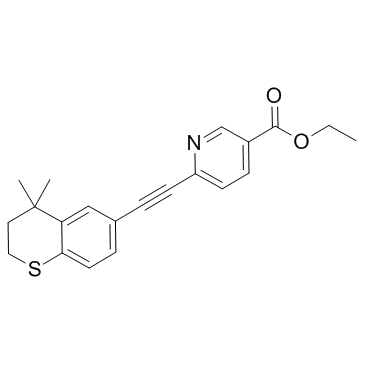
118292-40-3 |
| Literature: INDOCO REMEDIES LIMITED Patent: WO2009/116075 A2, 2009 ; Location in patent: Page/Page column 12 ; |
|
~% 
118292-40-3 |
| Literature: WO2006/59345 A2, ; Page/Page column 20-21 ; |
|
~% 
118292-40-3 |
| Literature: US2007/238881 A1, ; Page/Page column 6 ; |
|
~% 
118292-40-3 |
| Literature: US2007/238881 A1, ; Page/Page column 7 ; |
|
~% 
118292-40-3 |
| Literature: US2007/238881 A1, ; Page/Page column 7 ; |
|
~% 
118292-40-3 |
| Literature: Organic Process Research and Development, , vol. 9, # 5 p. 646 - 650 |
|
~% 
118292-40-3 |
| Literature: Organic Process Research and Development, , vol. 9, # 5 p. 646 - 650 |
|
~% 
118292-40-3 |
| Literature: Organic Process Research and Development, , vol. 9, # 5 p. 646 - 650 |
| Precursor 9 | |
|---|---|
| DownStream 1 | |
| HS Code | 2934999090 |
|---|---|
| Summary | 2934999090. other heterocyclic compounds. VAT:17.0%. Tax rebate rate:13.0%. . MFN tariff:6.5%. General tariff:20.0% |
